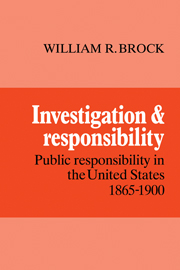Book contents
- Frontmatter
- Contents
- Dedication
- Preface
- 1 Public responsibility
- 2 Theory and practice
- 3 Public responsibility and the law
- 4 The charities of the State
- 5 The boards of public health
- 6 The bureaus of labor statistics
- 7 The railroad commissions
- 8 Toward the future
- Appendix 1 State agencies: some representative samples
- Appendix 2 Checklist of reports issued by boards of state charities, boards of public health, bureaus of labor statistics, and railroad commissions, 1865–1900
- Essay on sources and historiography
- Bibliography
- Index
2 - Theory and practice
Published online by Cambridge University Press: 03 May 2010
- Frontmatter
- Contents
- Dedication
- Preface
- 1 Public responsibility
- 2 Theory and practice
- 3 Public responsibility and the law
- 4 The charities of the State
- 5 The boards of public health
- 6 The bureaus of labor statistics
- 7 The railroad commissions
- 8 Toward the future
- Appendix 1 State agencies: some representative samples
- Appendix 2 Checklist of reports issued by boards of state charities, boards of public health, bureaus of labor statistics, and railroad commissions, 1865–1900
- Essay on sources and historiography
- Bibliography
- Index
Summary
The great majority of those who administered the agencies of the State were of north European descent, Protestant, and nurtured in business or professional environments. Unpaid members of boards were likely to be middle-aged or elderly, in affluent or comfortable circumstances, and to have behind them a successful career in business or a profession. Clergymen were often found on the boards of state charities, while the majority of members on a state board of health were usually required by law to be doctors with good medical qualifications. The salaried officers were likely to be younger, though the early secretaryships often went to veteran campaigners in the cause. As time went on, an increasing number of executive officers, agents, experts, and inspectors would be looking for a career in the service of the agency; but the great majority of them continued to be drawn from the same ethnic and religious environment as the older men. A partial exception was found in some bureaus of labor statistics, where the first appointees were often men who had been prominent in labor organization, but the trend was always away from graduates of the workbench and toward the recruitment of men who expected to make a career in statistical investigation or factory inspection. Another partial exception was found in the railroad commissions in states where the members were elected. In states where they were appointed they were most likely to be men with business and preferably with railroad experience, and even on elected commissions the trend was to seek for nomination men with this kind of qualification.
- Type
- Chapter
- Information
- Investigation and ResponsibilityPublic Responsibility in the United States, 1865–1900, pp. 24 - 57Publisher: Cambridge University PressPrint publication year: 1984



